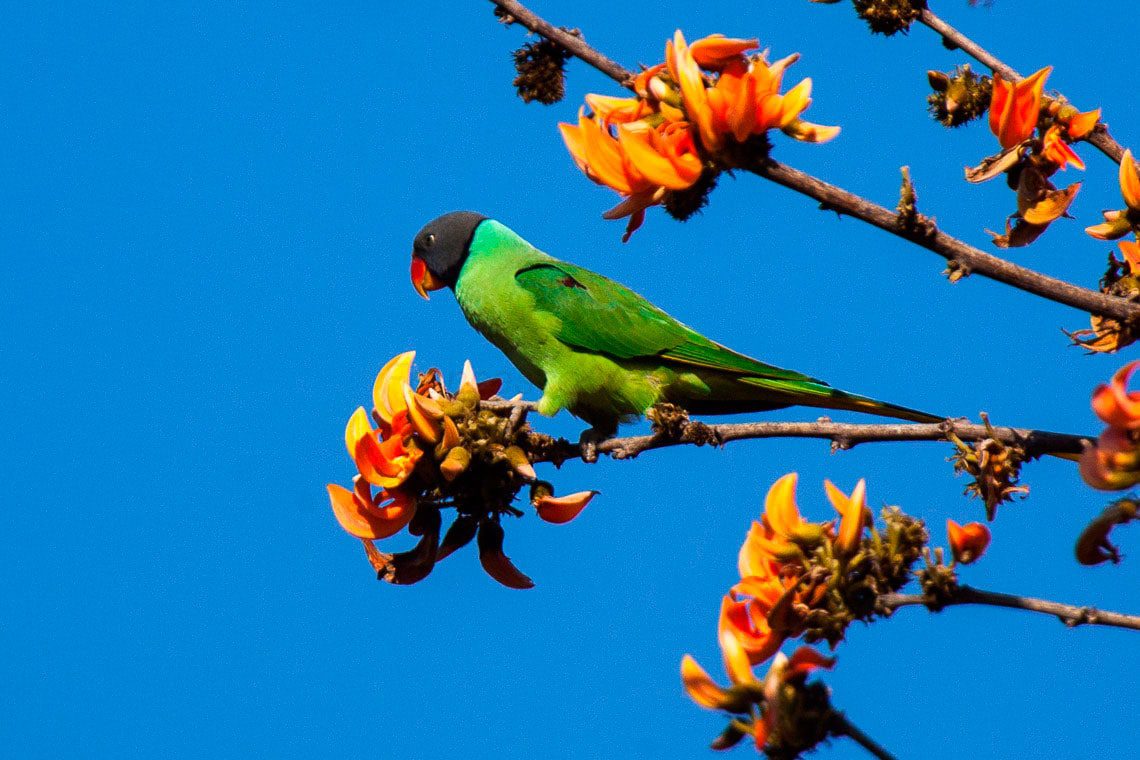Content |
|---|
Description:

Of 39 to 41 cm.. of length and a weight of 125 g..
The Slaty-headed Parakeet (Psittacula himalayana) has the forecrown, crown, lores and ear-coverts slaty-grey; chin and lower cheeks black, extending in the lateral narrow shaped collar black, to mark a clear boundary between the dark head and back neck bright green and nape, whose colour fades to duller green on rest of upperparts..
Lesser wing-coverts outer, green, brown the inner coverts, with a distinctive patch shoulder; remaining upperwing-coverts green.
The primaries Green with narrow yellow margins in vane outer; secondaries green. Underwing-coverts bluish green. Underparts bright pale green. Uppertail bright blue green, tipped chrome yellow color in the center, outer feathers green with yellowish tips; undertail-coverts bright yellow.
upper jaw orange-red, tipped pale yellowish, the lower yellower; cere whitish; irises creamy white; legs yellowish green.
The female smaller, more opaque in nape, usually with the tail shorter and often they lack the brown in the patch of the shoulders.
The immature with the head greenish brown opaque; acquire gray slate after first winter. The young birds they have the irises dark.
- Sound of the Slaty-headed Parakeet.
Habitat:
The Slaty-headed Parakeet Mountain forests are distributed, at altitudes around 2.500 meters in summer; rarely above the 250 meters in winter. Otherwise residents, although there are fluctuations depending on local food supply.
Occupy denser forest than most of its congeners, but preferably in extensions near orchards or farms with high trees. Registered in a variety of slopes and steep wooded valleys, including oak forests, cedars, Oak, rhododendrons and pines.
Observed, in general, in small flocks or family groups, no large gatherings, although flocks 50 birds have been recorded at the end of the monsoon.
Also registered with mixed banndadas Rose-ringed Parakeet, the Plum-headed Parakeet and Blossom-headed Parakeet. Registered a flock of 15 males during the month of November Nepal.
Reproduction:
The nest Slaty-headed Parakeet usually it located in a recess, on top of a tree, at an altitude between 6 and 20 m above the ground; a rotten branch used to excavate a cavity or modificadan the old nest of other species.
In East Afghanistan, the nest is ,normally, an old hole made by a Scaly-bellied Woodpecker (Pico squamatus).
Often several nests are close together.
The breeding season in the west of the range is between March and May, (maybe later at higher altitudes); they leave the breeding area in July; the laying is of 3 to 5 eggs.
Food:
The Slaty-headed Parakeet it feeds on various fruit, cultivated and wild, dried fruits and seeds, depending on the season.
Registered foods include berries of Cornus, Viburnum and Durant, seeds of Terminalia myriocarpa, seeds of Pine Pinus, acorns OAK wide and seedpods Dalbergia, flowers of Bauhinia purpurea and nectar of Woodfordia fruticosa.
Although the overall economic impact of this species is probably light, they are considered locally as a pest due to attacks on corn crops, Apple trees (flower and fruit), pear and walnuts Juglans regia.
Distribution:
Size of the area of distribution (reproduction / resident): 696.000 km2
The Slaty-headed Parakeet It is distributed by the Himalaya occidental, where they are, Commonly, above the 1.350 m, from the East of Afghanistan through northern Pakistan, northern India and Nepal until Bhutan, West of Arunachal Pradesh and Assam (about 92 it is) to the North of the Brahmaputra.
Conservation:
State of conservation ⓘ |
||
|---|---|---|
 Minor Concern ⓘ
(UICN)ⓘ
Minor Concern ⓘ
(UICN)ⓘ
| ||
• Current Red List of UICN: Least concern
• Population trend: Stable
The size of the world population Slaty-headed Parakeet It has not been quantified, but the species, according to sources, is usually common, although apparently very poorly documented in recent decades; uncommon in China.
The population is suspected to be stable in the absence of evidence of any reduction or substantial threats.
"Slaty-headed Parakeet" in captivity:
Fairly common in Australia, not so much in other places. In general, trade is not significant.
Alternative names:
– Slaty-headed Parakeet, Himalayan Slaty-headed Parakeet (English).
– Perruche de l’Himalaya, Perruche à tête ardoisée (French).
– Himalayasittich, Finsch-Sittich, Schwarzkopf-Edelsittich (German).
– Periquito-himalayana (Portuguese).
– Cotorra de Cabeza Pizarra, Cotorra del Himalaya (español).
scientific classification:

– Order: Psittaciformes
– Family: Psittaculidae
– Genus: Psittacula
– Scientific name: Psittacula himalayana
– Citation: (Lesson, 1832)
– Protonimo: Psittacus (conurus) äƒImlynus
Images "Slaty-headed Parakeet"
Videos "Slaty-headed Parakeet"
Slaty-headed Parakeet (Psittacula himalayana)
Sources:
– Avibase
– Parrots of the World – Forshaw Joseph M
– Parrots A Guide to the Parrots of the World – Tony Juniper & Mike Parr
– Birdlife
– Photos:
(1) – Slatina-headed Parakeet Psittacula Himalayas, Corbett National Park, India By Francesco Veronesi from Italy (Slaty-headed Parakeet – Corbett NP_1842) [CC BY-SA 2.0], via Wikimedia Commons
– Sounds: David Farrow (Xeno-canto)

